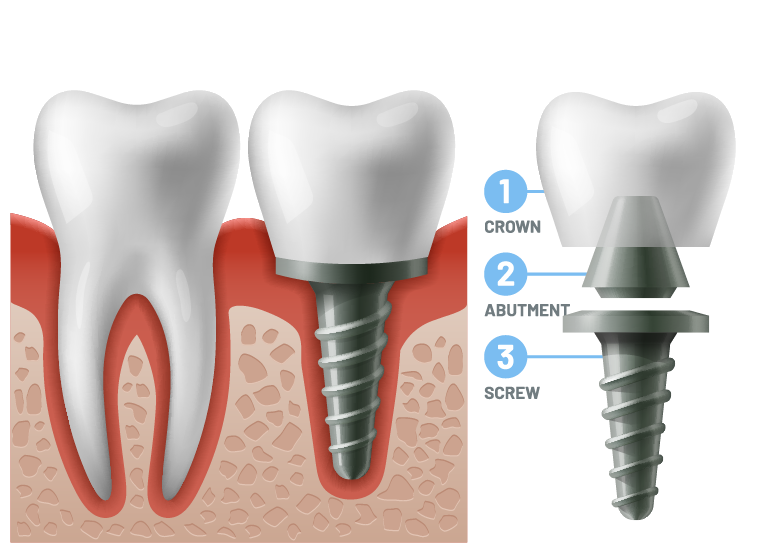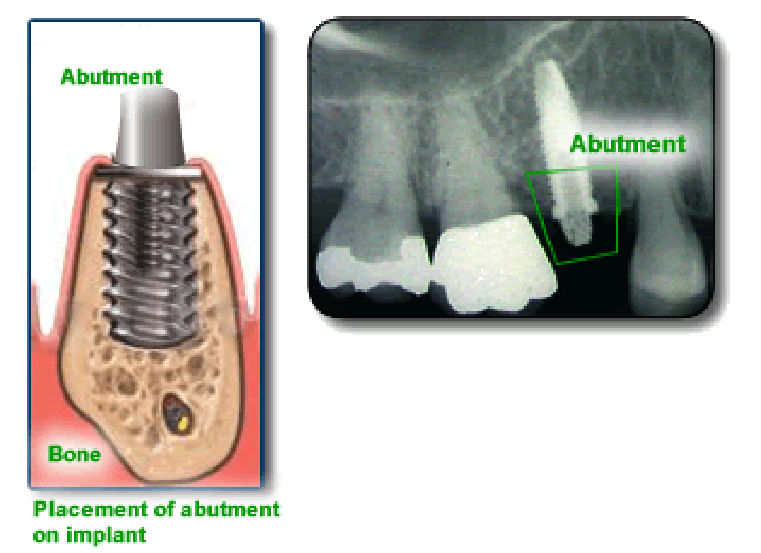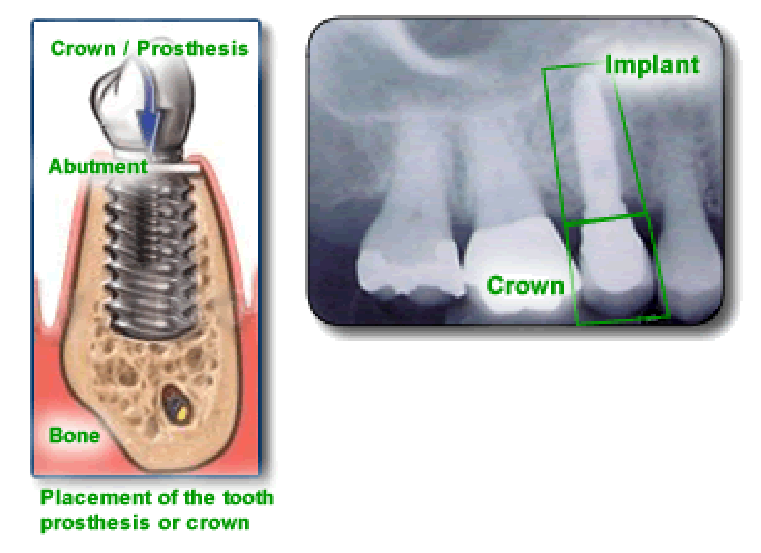 Dental implants are artificial teeth inserted into the upper or lower jawbone to prevent further gum and tooth loss. While there are other treatment options available for missing teeth, dental implants have proven to be the most successful and convenient. An implant acts and feels like any other tooth, so you only have to perform dental hygiene (brushing and flossing). This is not the case with other options. You cannot floss where you have a bridge, and dentures and partials must be removed every night. Partials can also contribute to the loss of adjacent teeth, requiring more than one partial over your lifetime. Studies have shown that with partials, 30% of the adjacent teeth are removed after five to seven years. Implants are permanent, and they appear and act like an ordinary tooth. The implant procedure is a three-step process. First, the implant is surgically placed in the jawbone beneath the gum tissue. The implant is a titanium screw that serves as the root of the tooth. After several weeks, an abutment (post) is attached on top of the metal cylinder, which serves as the foundation for the new tooth. Finally, a realistic-looking artificial tooth (crown) is attached to the abutment, making the implant appear like any other tooth in your mouth.
Dental implants are artificial teeth inserted into the upper or lower jawbone to prevent further gum and tooth loss. While there are other treatment options available for missing teeth, dental implants have proven to be the most successful and convenient. An implant acts and feels like any other tooth, so you only have to perform dental hygiene (brushing and flossing). This is not the case with other options. You cannot floss where you have a bridge, and dentures and partials must be removed every night. Partials can also contribute to the loss of adjacent teeth, requiring more than one partial over your lifetime. Studies have shown that with partials, 30% of the adjacent teeth are removed after five to seven years. Implants are permanent, and they appear and act like an ordinary tooth. The implant procedure is a three-step process. First, the implant is surgically placed in the jawbone beneath the gum tissue. The implant is a titanium screw that serves as the root of the tooth. After several weeks, an abutment (post) is attached on top of the metal cylinder, which serves as the foundation for the new tooth. Finally, a realistic-looking artificial tooth (crown) is attached to the abutment, making the implant appear like any other tooth in your mouth.
Who is a Good Candidate?
 Those that receive dental implants possess most if not all of the following qualities: Good overall health, sufficient jawbone to support an implant, good oral hygiene, and a commitment to regular dental visits. There are several instances where implants are recommended: tooth loss, root canal failure, cracked teeth, loss of a bridge, or loose or uncomfortable dentures or partials.
Those that receive dental implants possess most if not all of the following qualities: Good overall health, sufficient jawbone to support an implant, good oral hygiene, and a commitment to regular dental visits. There are several instances where implants are recommended: tooth loss, root canal failure, cracked teeth, loss of a bridge, or loose or uncomfortable dentures or partials.
There are several reasons you may not be the right candidate for implants. Being a smoker tends to slow healing in the mouth, which lessens the chance of success. Those with uncontrolled chronic diseases are not likely good candidates because certain conditions impair the gums' ability to heal. Dr. Hogan will discuss and determine the best course of action to ensure you have healthy teeth.
What is the success rate for dental implants?
Dental implants are very successful procedures in dentistry. There is no guarantee that an implant procedure will be successful, but studies have shown a success rate of 95% for lower-jaw implants and 90% for upper-jaw implants. The success rate for upper jaw implants is slightly lower because the upper jaw (especially the posterior section) is less dense than the lower jaw, making successful implantation and osseointegration (bone integration) potentially more challenging to achieve. Lower anterior implantation has the highest success rate for all dental implants.
Dental implants may fail for several reasons. The cause is often related to a failure in the osseointegration process. For example, if the implant is placed in a poor position, osseointegration may not take place. Dental implants may become infected (like natural teeth), and crowns may become loose.
Dental implants may fail for a number of reasons. The cause is often related to a failure in the osseointegration process. For example, if the implant is placed in a poor position, osseointegration may not take place. Dental implants may become infected (like natural teeth) and crowns may become loose.
On the plus side, dental implants are not susceptible to the formation of cavities; still, poor oral hygiene can lead to the development of peri-implantitis around dental implants. This disease is less likely on an implant than a natural tooth.
What is Involved When Placing a Dental Implant
Dental implant placement is a three-step process. All three stages can be completed with Dr. Hogan.
Step 1: Placement of the Implant
 Examination and Diagnosis: This involves an oral examination, full-mouth x-rays, panorex x-rays, diagnostic casts and/or photographs.
Examination and Diagnosis: This involves an oral examination, full-mouth x-rays, panorex x-rays, diagnostic casts and/or photographs.
Stage 1 Surgery- Implants (the surgical screws) are placed in the jaw. A soft diet is recommended during the first 2 weeks. Osseointegration (bone integration) occurs in 2 to 6 months.
Step 2: Uncovering and Placement of Abutment
 Stage 2 Surgery- Implants are uncovered. Implants are checked for bone integration. Healing abutments are placed.
Stage 2 Surgery- Implants are uncovered. Implants are checked for bone integration. Healing abutments are placed.
Note: Sometimes the implants (step 1) and abutments (step 2) can be done at the same time.
Step 3: Crown Placement
 Impression of mouth is done for the final prosthesis Crown placed over the abutment.
Impression of mouth is done for the final prosthesis Crown placed over the abutment.
Follow-Up Care: Oral hygiene maintenance is performed at 3 to 6 months intervals following placement of the final prosthesis. Regular and fastidious oral hygiene maintenance is the key to the long-term success of dental implants.
